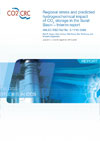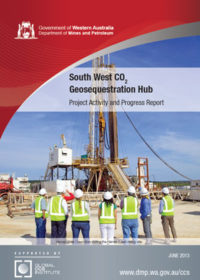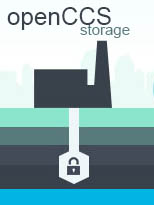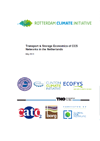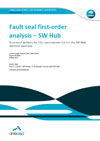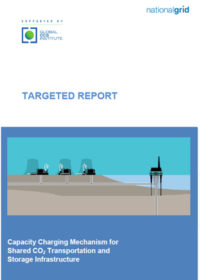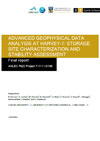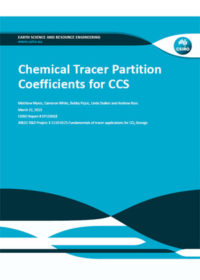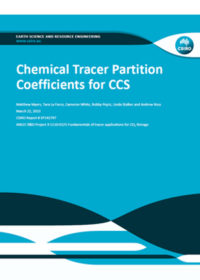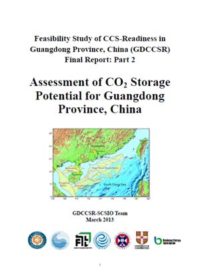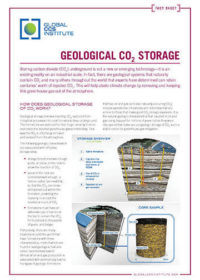Resources
Publications
Our publications, reports and research library hosts over 500 specialist reports and research papers on all topics associated with CCS.
View our Publication Library Disclaimer.
Filter by
Regional stress and predicted hydrogeochemical impact of CO2 storage in the Surat Basin: interim report
1st June 2013
Topic(s): Carbon capture use and storage (CCUS), CO2 storage
Early results of hydro-geochemical modelling for CO2 storage in the Surat Basin. This research is highly relevant to both potential CO2 injection operators and those statutory bodies that must regulate geosequestration operations in low salinity aquifers. The report provides early model assessments of geochemical influences of a greenhouse gas stream on both reservoir and seal rock types and the associated water chemistry. Importantly, these models use injection fluid compositions of CO2 , SOx and NOx that are broadly indicative of the composition of the major components of a GHG Stream sourced from coal-fired power stations.
Disclaimer
The content within the Global CCS Institute Publications, Reports and Research Library is provided for information purposes only. We make every effort and take reasonable care to keep the content of this section up-to-date and error-free. However, we make no claim as to its accuracy, currency or reliability.
Content and material featured within this section of our website includes reports and research published by third parties. The content and material may include opinions and recommendations of third parties that do not reflect those held by the Global CCS Institute.
South West CO2 Geosequestration Hub: project activity and progress report
1st June 2013
Topic(s): Carbon capture use and storage (CCUS), CO2 storage
The purpose of this report is to provide an overview of the South West Hub project and an update on recent activity and outcomes of the Harvey 1 well drilling program.
Disclaimer
The content within the Global CCS Institute Publications, Reports and Research Library is provided for information purposes only. We make every effort and take reasonable care to keep the content of this section up-to-date and error-free. However, we make no claim as to its accuracy, currency or reliability.
Content and material featured within this section of our website includes reports and research published by third parties. The content and material may include opinions and recommendations of third parties that do not reflect those held by the Global CCS Institute.
openCCS: Storage
28th May 2013
Topic(s): Capacity development, Carbon capture use and storage (CCUS), CO2 storage
openCCS is the handbook for delivering CCS projects brought to you by the Global CCS Institute. It has been built to guide you through the key processes and steps needed to deliver each component of an integrated CCS project. It’s a platform for sharing methodologies, best practices and lessons learnt from experience.
The Storage Section of the openCCS handbook contains:
Site Screening Studies
- Define screening basis
- Develop screening plan
- Review available data and identify potential sites
- Estimate capacity and level of uncertainty
- Shortlist storage sites
Site Assessment Studies
- Obtain exploration permit
- Define selection basis and develop selection plan
- Acquire data, test, analyse, rank risks
- Select site and engineering concept
Site Selection Studies
- Specify performance targets
- Prepare CO2 storage development plan
- Evaluate compliance with regulations and qualification goal
- Obtain storage permit
Design and (Initial) Construct
- Select construction contractor and delivery approach for (initial) storage assets (i.e. EPC)
- Complete the design detail for building the (initial) storage assets (i.e. wells, feeder piping)
- Build the organisation and systems to manage the storage assets
- Build the (initial) transport asset
- On time
- On budget
- To scope and quality
- Commission the (initial) storage assets to operating state
Operate (Remaining Construct)
- Operate the storage assets to achieve required performance over asset life
- Develop plan for permit review/re-qualification
- Reassess risks
- Adjust performance targets
- Adjust CO2 storage development plan
- Storage permit renewal
- Complete the design detail for building the (remaining) storage assets (i.e. wells, feeder piping)
- Select construction contractor and delivery approach for (remaining) storage assets (i.e. EPC)
Close
- Assess if conditions for site closure have been met
- Define closure basis
- Develop closure plan
- Update storage performance forecast and environmental impact assessment
- Obtain certificate of fitness for closure
- Initiate decommissioning
- Transfer of responsibility for site
Disclaimer
The content within the Global CCS Institute Publications, Reports and Research Library is provided for information purposes only. We make every effort and take reasonable care to keep the content of this section up-to-date and error-free. However, we make no claim as to its accuracy, currency or reliability.
Content and material featured within this section of our website includes reports and research published by third parties. The content and material may include opinions and recommendations of third parties that do not reflect those held by the Global CCS Institute.
Transport & storage economics of CCS networks in the Netherlands
22nd May 2013
Topic(s): CO2 storage, CO2 transport, Economics
A team from the Rotterdam Climate Initiative, CATO-2 (the Dutch national R&D programme on CCS) and the Clinton Climate Initiative, developed a financial model to assess the economics of alternative CO2 transport and storage options in the North Sea, based on common user infrastructure. The purpose of the financial model that is available on the Global CCS Institute website is to introduce a simple planning tool relating to the transport and storage components of an integrated CCS project using readily available, non-confidential data.
A steering group of major emitters with advanced plans for CCS projects in the Netherlands and Belgium guided the project. Although the report focusses on potential projects in the Netherlands (Rotterdam and Eemshaven) and Belgium (Antwerp) in the short to medium term, the analysis and lessons could be useful to other regions considering CO2 network solutions.
Disclaimer
The content within the Global CCS Institute Publications, Reports and Research Library is provided for information purposes only. We make every effort and take reasonable care to keep the content of this section up-to-date and error-free. However, we make no claim as to its accuracy, currency or reliability.
Content and material featured within this section of our website includes reports and research published by third parties. The content and material may include opinions and recommendations of third parties that do not reflect those held by the Global CCS Institute.
This report presents the information, discussions and key learning points from the 1st storage knowledge sharing event of 2013 held on 20 and 21 May 2013 in Doncaster, UK.
Disclaimer
The content within the Global CCS Institute Publications, Reports and Research Library is provided for information purposes only. We make every effort and take reasonable care to keep the content of this section up-to-date and error-free. However, we make no claim as to its accuracy, currency or reliability.
Content and material featured within this section of our website includes reports and research published by third parties. The content and material may include opinions and recommendations of third parties that do not reflect those held by the Global CCS Institute.
Fault seal first-order analysis – SW Hub: structural analysis for CO2 containment risk for the SW Hub, Western Australia
8th May 2013
Topic(s): Carbon capture use and storage (CCUS), CO2 storage
The Mandurah Terrace in the onshore central Perth Basin has been proposed as an environmentally suitable site for CO2 injection (i.e. the SW Hub) with the “storage complex” reservoir, primary and secondary seal represented by the Triassic lower Lesueur Sandstone (Wonnerup Member), the Late Triassic upper Lesueur Sandstone (Yalgorup Member) and the Early Jurassic basal Eneabba Formation, respectively. Prior investigations in the SW Hub region indicate that fault systems affect the target CO2 storage reservoir and the potential top seals and it is known that changes in the pore pressure and stress field induced by fluid injection could alter the initial seal performance of a reservoir by either overcoming the faults membrane seal capacity leading to across - or along - fault circulation of CO2 or by triggering slip on pre-existing faults leading to the potential along-fault circulation of CO2 . This project is integrated with others ANLEC R&D funded projects.
Disclaimer
The content within the Global CCS Institute Publications, Reports and Research Library is provided for information purposes only. We make every effort and take reasonable care to keep the content of this section up-to-date and error-free. However, we make no claim as to its accuracy, currency or reliability.
Content and material featured within this section of our website includes reports and research published by third parties. The content and material may include opinions and recommendations of third parties that do not reflect those held by the Global CCS Institute.
Capacity charging mechanism for shared CO2 transportation and storage infrastructure
5th May 2013
Topic(s): Carbon capture use and storage (CCUS), CO2 storage, CO2 transport
Technical and legal barriers to CCS and risks associated with the technology are diminishing. A serious obstacle to growth of the CCS industry, however, is difficulty in building a sound commercial case for the development and operation of CCS infrastructure. One way to significantly reduce the cost of CCS is to realise economies of scale by sharing a single CO2 transportation and storage infrastructure system among several operators of separate CO2 generating plants.
This report, prepared by National Grid Carbon (UK), sets out a commercial charging mechanism for the development of, access to, and subsequent use of a shared CCS infrastructure system. The study also explored a number of options for allocating the proportion of system development and operational costs between members of a shared CCS infrastructure.
Disclaimer
The content within the Global CCS Institute Publications, Reports and Research Library is provided for information purposes only. We make every effort and take reasonable care to keep the content of this section up-to-date and error-free. However, we make no claim as to its accuracy, currency or reliability.
Content and material featured within this section of our website includes reports and research published by third parties. The content and material may include opinions and recommendations of third parties that do not reflect those held by the Global CCS Institute.
Advanced geophysical data analysis at Harvey-1: storage site characterization and stability assessment. Final report
25th March 2013
Topic(s): Carbon capture use and storage (CCUS), CO2 storage
One of the first planned onshore commercial-scale CO2 geosequestration projects in Australia is at the South West Hub site, approximately 150 km south of Perth, WA. As part of the detailed characterisation work at the site, the new Harvey-1 Data Well was drilled in early 2012 to approximately 3km depth, penetrating the Lower Lesueur formation which is the main CO2 injection target. Its purpose was to obtain rock core samples and other physical data to reduce gaps in geological knowledge and help assess the suitability of the formation for CO2 storage. Drilling of the Harvey-1 Data Well has provided several geophysical data sets, including log data and zero-offset vertical seismic profiling (ZVSP) data. In addition, a set of 2D seismic lines was acquired in 2011, with basic image processing performed by a contractor. The main goal of this ANLEC research project is to apply a range of advanced data analysis techniques, developed by (or available to) WA:ERA researchers, to the geophysical datasets acquired at the Harvey-1 data well and the recently acquired 2D seismic data, in order to extract higher value from the data, reduce risk in the SW Hub CCS project through improved storage site characterisation, and guide optimal acquisition and processing parameters for future geophysical surveys.
Disclaimer
The content within the Global CCS Institute Publications, Reports and Research Library is provided for information purposes only. We make every effort and take reasonable care to keep the content of this section up-to-date and error-free. However, we make no claim as to its accuracy, currency or reliability.
Content and material featured within this section of our website includes reports and research published by third parties. The content and material may include opinions and recommendations of third parties that do not reflect those held by the Global CCS Institute.
Chemical tracer partition coefficients for CCS
22nd March 2013
Topic(s): Carbon capture use and storage (CCUS), CO2 storage
Disclaimer
The content within the Global CCS Institute Publications, Reports and Research Library is provided for information purposes only. We make every effort and take reasonable care to keep the content of this section up-to-date and error-free. However, we make no claim as to its accuracy, currency or reliability.
Content and material featured within this section of our website includes reports and research published by third parties. The content and material may include opinions and recommendations of third parties that do not reflect those held by the Global CCS Institute.
Chemical tracer partition coefficients for CCS
22nd March 2013
Topic(s): Carbon capture use and storage (CCUS), CO2 storage
This project studies the use of chemical tracers to track the migration of CO2 once it’s injected underground and to monitor the containment security. Once injected, tracers partition between the CO2 and the other fluids present in the system. Supercritical CO2/water partition coefficients are established for a number of chemical tracers relevant to CCS. This study will improve estimates and correlations for characterising reservoir capacity.
Disclaimer
The content within the Global CCS Institute Publications, Reports and Research Library is provided for information purposes only. We make every effort and take reasonable care to keep the content of this section up-to-date and error-free. However, we make no claim as to its accuracy, currency or reliability.
Content and material featured within this section of our website includes reports and research published by third parties. The content and material may include opinions and recommendations of third parties that do not reflect those held by the Global CCS Institute.
Assessment of CO2 storage potential for Guangdong Province, China
1st March 2013
Topic(s): Capacity development, Carbon capture use and storage (CCUS), CO2 storage, Project financing
This report, authored by the GDCCSR-SCSIO Team, is the second part of the final reports of The CCS Readiness Study for Guangdong Province (GDCCSR) project. In this report, the effective storage capacity of CO2 in sedimentary basins onshore Guangdong (the Sanshui Basin) and offshore (the Pearl River Mouth Basin, Beibuwan Basin, Qiongdongnan Basin, and Yinggehai Basin) are assessed based on available geological data. It is concluded that the CO2 storage potential is limited inland Guangdong but abundant offshore. The offshore sedimentary basins in northern South China Sea, especially the Pearl River Mouth Basin, have sufficiently large and high-quality storage potential for storing the CO2 from Guangdong province in over one hundred years.
Disclaimer
The content within the Global CCS Institute Publications, Reports and Research Library is provided for information purposes only. We make every effort and take reasonable care to keep the content of this section up-to-date and error-free. However, we make no claim as to its accuracy, currency or reliability.
Content and material featured within this section of our website includes reports and research published by third parties. The content and material may include opinions and recommendations of third parties that do not reflect those held by the Global CCS Institute.
Disclaimer
The content within the Global CCS Institute Publications, Reports and Research Library is provided for information purposes only. We make every effort and take reasonable care to keep the content of this section up-to-date and error-free. However, we make no claim as to its accuracy, currency or reliability.
Content and material featured within this section of our website includes reports and research published by third parties. The content and material may include opinions and recommendations of third parties that do not reflect those held by the Global CCS Institute.
